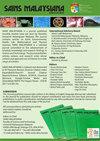FFPET切片制备的单细胞悬液中肿瘤细胞CD44+亚群比例与头颈部鳞状细胞癌的组织学分型直接相关
IF 0.8
4区 综合性期刊
Q3 MULTIDISCIPLINARY SCIENCES
引用次数: 0
摘要
CD44在肿瘤中的表达赋予了进展、转移、复发和抗肿瘤治疗耐药性的潜力。在本研究中,我们试图描述不同组织学分级和亚型的头颈部鳞状细胞癌(HNSCC)中MDR1+和CD44+潜在癌症干细胞免疫表达和计数的变化。使用抗CD44和抗MDR1/ABCB-1一级单克隆抗体对由HNSCC的福尔马林固定石蜡包埋组织(FFPET)切片制备的单细胞悬浮液进行流式细胞术分析。还使用这两种抗体在安装在超磨砂玻璃载玻片上的HNSCC组织切片上进行免疫组织化学(IHC)染色。免疫组化分析CD44和MDR1的平均IRS分别为8.6364±3.02114和1.5909±1.27674。当CD44抗体和MDR1/ABCB-1的平均免疫表达评分与HNSCC的组织学分级和亚型进行比较时,发现这种关系在统计学上不显著。有趣的是,当使用流式细胞术分析在HNSCC的不同组织学亚型之间比较具有细胞干性特征的发育异常鳞状上皮细胞亚群(CD326+CD44+)的平均得分时,观察到强烈的统计学差异(p=0.000)。当在HNSCC的不同组织学亚型之间比较发育异常细胞亚群的平均得分与潜在耐药性(CD44+MDR1+)时,没有观察到统计学上的显著关联。尽管潜在的癌症干细胞标志物CD44和多药耐药性标志物ABCB-1/MDR1在HNSCC中共表达,但肿瘤细胞的CD326+CD44+亚群(潜在的癌症干细胞/CCS)的比例与侵袭性最低至侵袭性更强的肿瘤亚型显著相关。本文章由计算机程序翻译,如有差异,请以英文原文为准。
Proportion of CD44+ Subset of Tumour Cells in Single Cell Suspension Prepared from FFPET Sections Directly Correlates with Histological Subtyping of Head and Neck Squamous Cell Carcinoma
CD44 expression in tumours imparts potential to progress, metastasize, recurrence, and resistance against antineoplastic therapy. In this study, we sought to describe the variation in the immuno-expression and numeration of MDR1+ and CD44+ potential cancer stem cells in different histological grades and subtypes of head and neck squamous cell carcinoma (HNSCC). Flow-cytometric analysis was performed on single cell suspension prepared from formalin fixed paraffin embedded tissue (FFPET) sections of HNSCC using anti-CD44 and anti-MDR1/ABCB-1 primary monoclonal antibodies. Immunohistochemical (IHC) staining was also carried out using both of these antibodies on HNSCC tissue sections mounted on super frosted glass slides. On immunohistochemical analysis, the mean IRS for CD44 and MDR1 were 8.6364 ±3.02114 and 1.5909 ±1.27674 respectively. When mean immune-expression scores of CD44 antibody and MDR1/ABCB-1 were compared with histological grades and subtypes of HNSCC, the relationship was found to be statistically insignificant. Interestingly, a strong statistical difference (p = 0.000) was observed when the mean score of subset of dysplastic squamous epithelial cells with characteristics of cell stemness (CD326+CD44+) was compared among different histological subtypes of HNSCC using flowcytometric analysis. While no statistically significant association was observed when the mean score for subset of dysplastic cells with potential of drug resistance (CD44+MDR1+) was compared among different histological subtypes of HNSCC. Although potential cancer stem cell marker CD44 and the multidrug resistance maker ABCB-1/MDR1 co-expressed in HNSCC but the proportion of CD326+CD44+ subset of tumour cells (potential cancer stem cells/CSCs) significantly correlates with least aggressive to more aggressive tumour subtypes.
求助全文
通过发布文献求助,成功后即可免费获取论文全文。
去求助
来源期刊

Sains Malaysiana
MULTIDISCIPLINARY SCIENCES-
CiteScore
1.60
自引率
12.50%
发文量
196
审稿时长
3-6 weeks
期刊介绍:
Sains Malaysiana is a refereed journal committed to the advancement of scholarly knowledge and research findings of the several branches of science and technology. It contains articles on Earth Sciences, Health Sciences, Life Sciences, Mathematical Sciences and Physical Sciences. The journal publishes articles, reviews, and research notes whose content and approach are of interest to a wide range of scholars. Sains Malaysiana is published by the UKM Press an its autonomous Editorial Board are drawn from the Faculty of Science and Technology, Universiti Kebangsaan Malaysia. In addition, distinguished scholars from local and foreign universities are appointed to serve as advisory board members and referees.
 求助内容:
求助内容: 应助结果提醒方式:
应助结果提醒方式:


